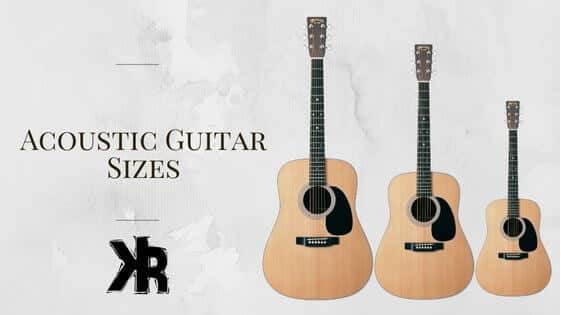Table of Contents
Acoustic guitars are a staple in the world of music, offering a range of sounds that can suit various genres and playing styles.
For anyone considering buying one or simply wanting to understand the instrument better, knowing the different types of acoustic guitars available is crucial.
This Killer Rig article aims to provide a detailed guide to the various types of acoustic guitars, their characteristics, and their suitability for different musical styles. No matter where you are on your journey, this information can help you make an informed decision.
Acoustic Guitar Type Summary
There are many different types of acoustic guitars, each with its own characteristics. Here are some of the most common types:
- Dreadnought: This is the most popular type of acoustic guitar. It has a large body and a deep sound, making it great for strumming and flatpicking. It’s commonly used in country, folk, and bluegrass music.
- Grand Auditorium: This type of guitar has a slightly smaller body than the dreadnought, but still produces a full sound. It’s versatile and can be used for a variety of playing styles, including fingerpicking and strumming. It’s commonly used in pop, rock, and country music.
- Grand Concert: This type of guitar has a smaller body than the grand auditorium, making it easier to play for people with smaller hands. It produces a clear and balanced sound, making it great for fingerpicking and light strumming. It’s commonly used in classical and fingerstyle music.
- Classical: This type of guitar has a wider neck and nylon strings, giving it a softer and warmer sound. It’s commonly used in classical and flamenco music.
- Parlor: This type of guitar has a small body and a bright sound. It’s great for fingerpicking and blues music.
- Jumbo: This type of guitar has a large body and a deep sound, similar to the dreadnought. It’s great for strumming and flatpicking, and is commonly used in country and rock music.
- Travel: This type of guitar is smaller than most other types, making it easy to transport. It’s great for practicing and playing on the go.
- 12-String: This type of guitar has 12 strings instead of the usual 6, giving it a fuller and richer sound. It’s commonly used in folk and rock music.
- Resonator: This type of guitar has a metal resonator cone instead of a sound hole. This gives it a very different sound. It’s commonly used in blues and bluegrass music.
Types Of Acoustic Guitars
Acoustic guitars come in a variety of shapes, each offering its own sound and playability. Below are some of the classic types of acoustic guitars that have stood the test of time, each with its own set of characteristics and best uses.
Parlor
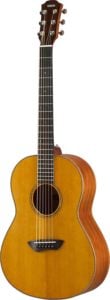
- Characteristics: With its small body and focused sound, the Parlor guitar is perfect for solo performances and offers excellent portability.
- Best for: Blues, folk, and fingerstyle.
Parlor guitars are one of the oldest styles of acoustics. Dating back to the late 19th century! They have a smaller body than most other acoustic guitars. This is because they were originally designed for use in small parlors or drawing rooms.
The parlor, being smaller, also had a softer mid-range sound. It’s the perfect choice for entertaining guests. And so they are often prized for their sweet, mellow tone. Many players favor them because they can work well for fingerpicking styles or blues.
Pros
- Portability: One of the most noticeable benefits of a Parlor guitar is its smaller size, making it easy to transport and ideal for musicians on the go.
- Focused Sound: The smaller body produces a more focused and articulate sound, which is excellent for fingerstyle techniques and solo performances.
- Comfort: Its compact size and lighter weight make it comfortable to play, especially for those who find larger guitars cumbersome or difficult to manage.
Cons
- Limited Volume: Due to its smaller body, a Parlor guitar doesn’t have the same volume and projection as larger types like the Dreadnought, which can be a drawback in certain performance settings.
- Narrower Tonal Range: While it excels in producing focused and articulate tones, it may lack the deep bass and sonic richness that some other types offer.
- Not Ideal for Strumming: The focused sound and smaller body don’t lend themselves well to aggressive strumming, as the tone can become thin or tinny.
Concert
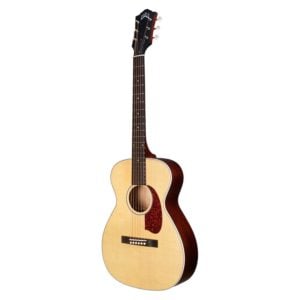
- Characteristics: Smaller than the Dreadnought, the Concert guitar offers a more balanced tone and is easier to handle, making it ideal for smaller players.
- Best for: Folk music and fingerstyle playing.
Concert-sized guitars are slightly larger than the parlor. But, they are still smaller than traditional dreadnought or jumbo acoustic guitars. They are often more comfortable to play than larger guitars and have a balanced tone.
They can work well for a variety of styles. The concert size is popular with fingerstyle players. They appreciate their responsiveness and clarity. With this size, the scale length becomes longer.
Yet, the string tension is still lower than a dreadnought. So you get strings that are easy to press and a larger frequency range that can add flexibility to your sound.
Pros
- Ease of Playability: The Concert’s smaller body and lighter weight make it easy to handle, especially for players who find larger guitars cumbersome. This makes it a good choice for beginners or those with smaller frames.
- Focused and Clear Sound: The Concert guitar is known for its clear, well-defined sound, particularly in the mid and upper ranges. This makes it excellent for fingerstyle techniques and solo performances.
- Versatile: Despite its smaller size, the Concert guitar is quite versatile and can be used for a variety of musical styles, including folk and acoustic rock.
Cons
- Limited Volume: Due to its lower body size, the concert guitar lacks the volume and projection of bigger models, which can be problematic in some performing contexts.
- Less Bass Response: While it excels in clarity, it may lack the deep bass that some players prefer, especially for genres that require a fuller sound.
Auditorium
- Characteristics: Falling between the Dreadnought and Concert in size, the Auditorium guitar offers a balanced sound that’s well-suited for both strumming and fingerpicking.
- Best for: Versatile musicians who play a range of styles.
Auditorium guitars are slightly larger than the concert size. They have a rounded shape that provides a fuller, more balanced sound.
They are versatile instruments that can be used for a variety of playing styles. This includes fingerpicking, strumming, and flatpicking. They are popular with acoustic and folk musicians due to their rich, warm sound.
Pros
- Balanced Sound: The Auditorium guitar offers a well-balanced sound that works well for both strumming and fingerpicking. Its mid-sized body allows for a good mix of bass and treble frequencies.
- Comfortable Size: Falling between the smaller Concert and the larger Dreadnought, the Auditorium is often considered a comfortable middle ground, making it suitable for a wide range of players.
- Good for Live Performances: Its balanced sound and moderate size make the Auditorium a reliable choice for live performances, where versatility is key.
Cons
- Not Specialized: While it’s a versatile instrument, the Auditorium may not excel in any specific area, such as deep bass or high treble, compared to more specialized guitar types.
- Moderate Projection: Although it’s good for live settings, it may not project as loudly as larger-bodied guitars, which could be a limitation in certain performance scenarios.
- Price Range: Auditorium guitars can vary widely in price, and higher-quality models can be expensive, potentially making them less accessible for beginners or those on a budget.
Grand Concert
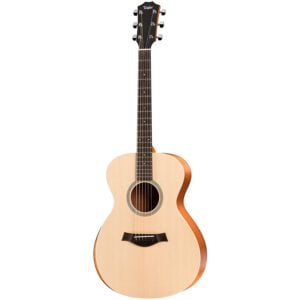
The grand concert is louder and offers more benefits. They were introduced in 1984 to meet the needs of fingerstyle players. They are perfect for anyone who wanted more comfort and a pronounced version.
The body is still smaller than the dreadnought-style guitars. They have lower string tension and a slightly smaller scale length. The tapered waist and wider neck are a fingerpicker’s dream.
The grand concert doesn’t have a huge bass sound, but is fine-tuned to keep the overtones in check. This is all thanks to the tapered waist.
The Grand concert is an excellent choice when there are a lot of other instruments in a mix. It’s a perfect fit for performances or recordings. So when looking at acoustic guitar sizes and shapes, you should consider this design.
Pros
- Balanced Tone: The Grand Concert offers a well-balanced tone that excels in both the bass and treble frequencies. This makes it a versatile choice for a variety of musical genres.
- Ease of Playability: Its smaller body and narrower waist make it easier to play, especially for musicians who prefer a more manageable size or those who engage in complex fingerstyle techniques.
- Good for Recording: The balanced tone and moderate volume of the Grand Concert make it an excellent choice for recording, as it can capture a wide range of frequencies without overpowering the mix.
Cons
- Limited Projection: While it has a balanced tone, the Grand Concert’s smaller body size means it doesn’t project as loudly as larger-bodied guitars like the Dreadnought or Jumbo.
- Less Bass Response: Although it has a balanced tone, it may lack the deep bass response that some musicians prefer for certain styles of music.
- Not Ideal for Heavy Strumming: Its balanced and moderate volume levels may not stand up well to aggressive strumming, where a louder, more resonant sound is often desired.
By considering these pros and cons, you can better determine if a Grand Concert acoustic guitar aligns with your musical objectives and playing style.
Grand Auditorium
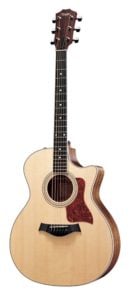
The grand auditorium is another mid-sized acoustic guitar. It was designed to be well-balanced in sound. This is where a finger, and a flat picker, can come together and meet in the middle.
Introduced in 1994 by Taylor acoustic guitars, it became popular for its versatility. Musicians have embraced the smaller body shape and well-balanced sound.
The grand auditorium’s body shape can cover many playing styles. It can also hold up well in many genres of music. It also has some great features like electronics on board and a cutaway. These options alone make this a versatile acoustic with a comfortable scale length!
Pros
- Balanced Sound: The Grand Auditorium is known for its well-balanced sound that doesn’t favor the bass or treble too heavily. This makes it a versatile choice for a wide range of musical styles.
- Good for Multiple Techniques: Whether you’re into fingerstyle or strumming, this guitar’s design accommodates both. Its shape allows for comfortable play, making it easier to switch between different techniques.
- Moderate Size: Falling between smaller and larger body types, the Grand Auditorium offers a good balance of comfort and sound projection, making it a practical choice for many players.
Cons
- Not the Loudest: While it has good projection, it may not be as loud as some of the larger-bodied guitars, which could be a limitation in certain performance settings.
- Jack-of-All-Trades: Because it’s so balanced, it may not excel in any one particular area. For example, it might lack the deep bass of a Jumbo or the focused clarity of a Parlor.
- Price: Grand Auditorium guitars often come with a higher price tag due to their versatility and the quality of construction, which might not be suitable for all budgets.
Grand Symphony
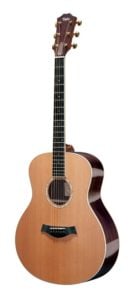
Introduced in 2006, the grand symphony body style delivers a rich and powerful sound. It’s pretty much a full-sized guitar! The dimensions of the guitar are larger than that of the grand auditorium. This gives it a boost in sound and volume.
The lower bout is a bit larger than the auditorium body style. It also has a wider waist, expanding the bass and lower mid-range.
The string tension is tighter. A driving pick attack will produce fullness, volume, and sustain. This makes it popular for strummers, but responsive enough for fast picking runs as well!
Pros
- Wide Tonal Range: The Grand Symphony offers a broad tonal range, making it versatile for different styles of music. It can handle both low and high frequencies well, providing a balanced sound.
- Strong Projection: Its larger body size allows for excellent sound projection, making it a good choice for live performances where you want the guitar to be heard clearly.
- Versatility: This type of guitar is well-suited for both fingerstyle and strumming techniques, offering flexibility for musicians who like to switch between different playing styles.
Cons
- Size: The larger body may not be comfortable for all players, particularly those who are smaller or prefer a more manageable instrument.
- Potential for Overpowering Sound: While its wide tonal range is a strength, it can sometimes produce a sound that’s too strong or overpowering for more delicate musical pieces.
- Feedback Issues: Similar to other large-bodied guitars, the Grand Symphony can be more susceptible to feedback when amplified, requiring careful sound adjustments.
Dreadnought
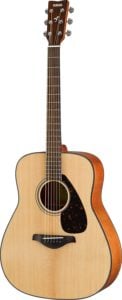
- Characteristics: Known for its large body and robust sound, the Dreadnought is a versatile choice that excels in both strumming and fingerpicking.
- Best for: Rock, country, and bluegrass music.
The dreadnought acoustic guitar was developed by C.F. Martin & Co. in 1916 and is the most common style. The deep low-end, mid-range, and articulate treble, have caught the attention of musicians.
With a wider waist and larger body style, the dreadnought will sit higher in your lap. But might be big for smaller musicians. Yet, the powerful tone and loudness are often reason enough to overlook the size.
Options like onboard electronics and a cutaway begin to serve the player’s needs. This makes the dreadnought an even more powerful tool. Over the years, manufacturers have refined the shape to make it more comfortable. Making it easy for anyone to get into a dreadnought.
The dreadnought body style is recommended for musicians who need a workhorse of a guitar. One that meets most demands no matter what the situation.
From recording to touring or campfires and travel, this is a well-rounded model. It’s the most common for a reason in the full-sized guitar category.
Pros
- Versatile Sound: The Dreadnought is known for its robust and balanced sound, making it suitable for a wide range of musical styles, from rock to country to bluegrass.
- Volume and Projection: Its large body size allows for greater sound projection, making it ideal for performances where you need the guitar to be heard clearly, even without amplification.
- Comfortable for Most: While it’s one of the larger guitar types, many players find the Dreadnought’s shape to be comfortable and easy to manage, especially when seated.
Cons
- Size: The Dreadnought’s larger body might not be comfortable for all players, particularly those who are smaller in stature or younger musicians.
- Not Ideal for Fingerstyle: While versatile, the Dreadnought’s sound can sometimes be too boomy or overpowering for intricate fingerstyle play, where a more balanced or treble-focused tone is often preferred.
- Potential for Feedback: When amplified, the Dreadnought’s larger body can be more susceptible to feedback issues compared to smaller-bodied guitars, requiring careful mic placement or sound adjustments.
Jumbo
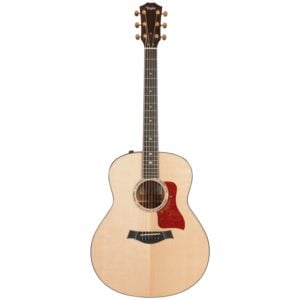
The jumbo acoustic size adds even more volume and frequency response. It’s perfect for those who want more! This body style has a larger lower bout and a more pronounced waist. It’s produced with small differences depending on the manufacturer.
The jumbo can still get some good response from a light touch, but the real volume is created when you give it more!
If you are a smaller musician, it may be a challenge to play the jumbo guitar. Reaching over the larger waist and getting comfortable could be difficult. Even though the scale length is similar to a dreadnought
But if you can swing it and want that extra punch from your instrument, the jumbo is where it’s at as a full-sized guitar!
Pros
- Rich, Full Sound: The Jumbo’s large body size contributes to a rich, full sound that excels in both bass and treble frequencies, making it a versatile choice for various musical styles.
- Strong Projection: Thanks to its size, the Jumbo guitar has excellent sound projection. This is beneficial for live performances where you want the guitar to fill the room.
- Good for Strumming: The Jumbo’s robust sound and strong projection make it particularly well-suited for strumming techniques, where it can produce a full, resonant tone.
Cons
- Size and Weight: The Jumbo’s large body can be cumbersome and may not be comfortable for all players, especially those who are smaller or prefer a more manageable size.
- Not Ideal for Fingerstyle: While it’s a versatile instrument, its large body and powerful sound can sometimes overpower more delicate fingerstyle techniques.
- Potential for Feedback: Similar to the Dreadnought, the Jumbo’s large body can be more susceptible to feedback issues when amplified, requiring careful sound adjustments or mic placement.
Specialty Types
When you’re looking to go beyond the standard acoustic guitar options, a world of specialized instruments awaits.
12-String
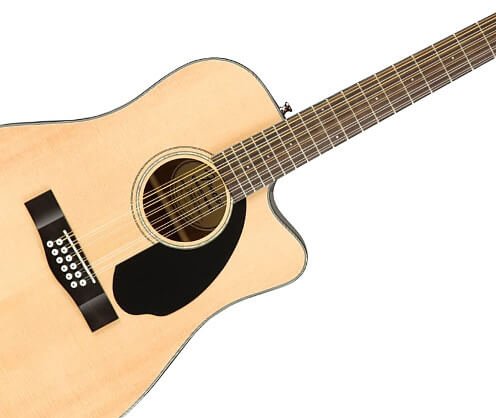
The 12-String guitar is like having two in one. With its double set of strings, it produces a rich, full sound that adds a layered, chorus-like effect to your music. It’s especially popular in folk, rock, and pop genres where a fuller sound can make all the difference.
Resonator
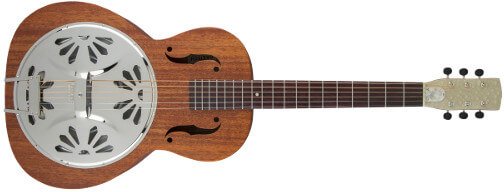
For those who love slide guitar, blues, or bluegrass, the Resonator is a solid choice. Instead of a wooden soundboard, it uses a metal resonator to amplify the sound. This results in a loud, metallic tone that can easily stand out in a mix of instruments.
Classical
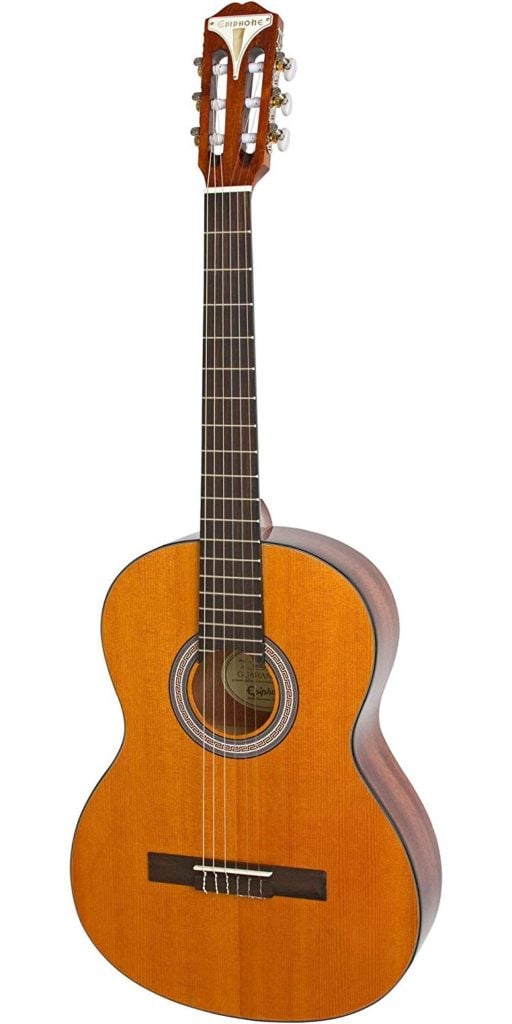
If you’re into intricate fingerstyle techniques, the Classical guitar is a natural fit. Its nylon strings and wider neck produce a soft, warm sound that’s perfect for complex picking and strumming. It’s commonly used for classical compositions and Latin music.
Travel
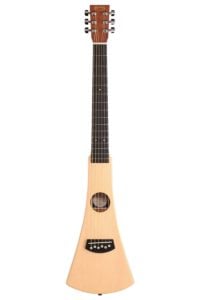
Travel guitars are designed specifically for portability. With a smaller size and often a compact shape. They can fit in an airplane overhead compartment or a backpack. They usually have a shorter scale length than other guitars.
This can make them more comfortable to play for those with smaller hands. However, due to their smaller size, they may not have the same level of projection. Volume levels are often lower than larger guitars.
Mini Acoustic
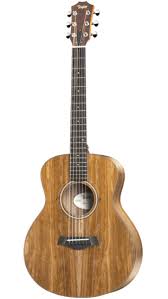
Mini guitars are often marketed as children’s or practice instruments. They are easy to handle and can be a good option for those with very small hands. Or even those who are just starting out with the instrument. However, due to their small size, they may not have the same level of sound quality as larger guitars.
Some also come with electronics and other options that provide a great experience. The GS mini is a smaller version of the grand symphony body style produced by Taylor. When properly designed, a mini acoustic can be a great experience.
Baritone
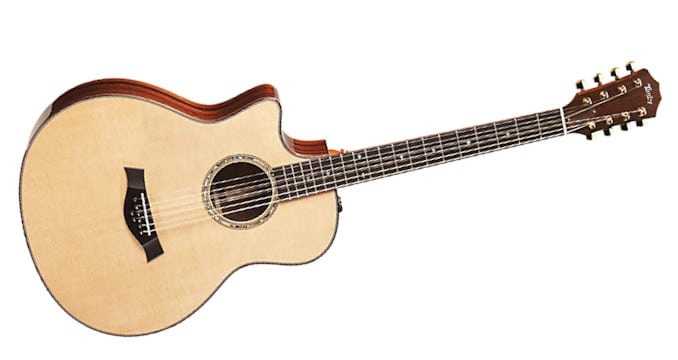
If you’re looking to explore deeper tones, the Baritone is tuned lower than standard guitars. It offers a deep, resonant sound that adds depth to any musical arrangement. It’s often used in jazz and experimental music to add a different kind of depth to compositions.
Silent Guitar
The silent guitar is a unique type of acoustic designed for practice, recording, and performance situations where minimizing external noise is crucial. Some of these guitars are equipped with a headphone output, allowing the player to hear the sound without disturbing others.
Silent guitars typically feature a slim body design that reduces the resonance and volume of the instrument. This allows the player to practice or perform with minimal acoustic sound.
Acoustic Guitar Sizes
Small-size acoustic guitars are generally defined as having smaller bodies than others. It makes them easier to handle and play for those with smaller body frames or for travel purposes. There are several types of small-size acoustic guitars. Below you will find the most common sizes.
Mini Guitars
Mini guitars, also known as half or 3/4 size, are a popular choice for those seeking a compact and portable instrument.
These guitars maintain the essential characteristics of a full-sized acoustic while offering the convenience of a smaller size. Mini guitars typically come in a few different sizes to cater to various needs and preferences.
Piccolo Guitars
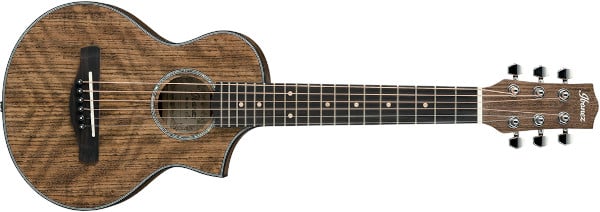
Piccolo or requinto guitars, are another type of mini with a unique, higher-pitched sound. These instruments usually have a scale length between 18 and 20 inches, making them even smaller than the 1/2 size guitars.
They are typically tuned a fourth or fifth higher than a standard guitar, resulting in a brighter tone. Piccolo guitars are often used in ensemble settings or for solo performances where a distinct and higher-pitched sound is desired.
Their compact size and distinct tonal qualities make them an interesting and versatile option within the mini guitar category.
1/2 Size Guitars
The 1/2 size are generally around 30 to 32 inches in length. These guitars are an excellent option for children between the ages of 5 and 8, as they provide a comfortable fit for smaller people.
Due to their size, these guitars are also perfect for those who want an ultraportable instrument for practice sessions.
3/4 Size Guitars
The 3/4 size guitars are slightly larger than the half models, with a length of about 36 inches. These are suitable for older children or adults with smaller hands. But also those looking for a more compact and lightweight instrument for travel.
The 3/4 size retains much of the tonal quality of a full-sized guitar while being easier to handle and transport.
7/8 Size Guitars
The largest of the mini guitars, 7/8 size, are around 39 inches in length. These guitars provide a slightly bigger body and longer scale length, delivering a fuller sound and greater projection.
They are an ideal choice for players with smaller hands who still want the fullness of tone and volume that a full-sized guitar offers. But also for those who need a portable instrument without sacrificing too much in sound quality.
Factors to Consider When Choosing a Type
When you’re in the market for an acoustic guitar, several factors come into play that can influence your decision. Here’s a rundown of some key considerations:
Sound
The type of music you want to play will largely dictate the kind of sound you need from your guitar. Some guitars are better suited for a robust, full-bodied sound, while others excel in clarity and focus. Make sure to try out different types to see which sound profile fits your musical style.
Playability
Comfort is crucial when it comes to playing an instrument. The guitar’s body size, neck width, and string type can all impact how easy it is to play. Smaller-bodied guitars like the Concert and Parlor are generally easier to handle, especially for beginners or those with smaller frames.
Price
Guitars come in a wide range of prices, from budget-friendly options to high-end models. Your budget will undoubtedly influence your choice, but it’s essential to find a balance between cost and quality. Sometimes, spending a bit more can give you a guitar that not only sounds better but will also last longer.
Skill Level
Your level of expertise can also guide your decision. Beginners might opt for guitars that are easier to play and less expensive, while more experienced players may look for specialized features that align with their advanced techniques.
Purpose
Are you looking for a guitar for casual play, live performances, or recording? Each setting may require different features. For example, a guitar with strong projection may be ideal for live performances, while a balanced sound is often preferred in recording settings.
Conclusion
Picking the right acoustic guitar size isn’t just important, it’s critical! Novice or veteran, it doesn’t matter! Sizing your guitar correctly is essential to your playing journey.
Consider it like solving a puzzle, there are many pieces to look at. How do you figure it out?
Testing out different guitar models is like trying on new shoes. You want to find the one that fits just right and feels like it was made for you. And don’t forget, it should also sound like music to your ears!
And hey, don’t shy away from asking for advice. Those who’ve been strumming strings for a while, or the helpful folks at your local music shop, they’ve got wisdom to share.
So go on, hunt for the guitar size that truly clicks with you. And then sit back and let the magic of playing music sweep you away.

